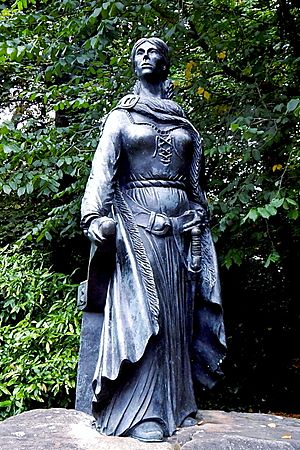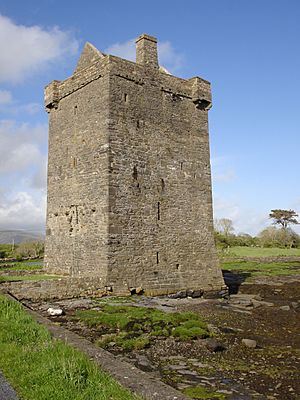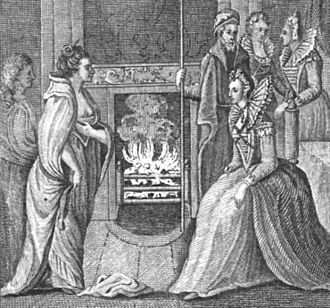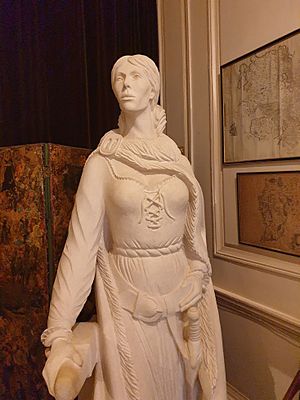Grace O'Malley facts for kids
Quick facts for kids
Gráinne O'Malley
|
|
|---|---|
| Gráinne Ní Mháille | |

|
|
| Born | c. 1530 Umhaill, Connacht, Ireland
|
| Died | c. 1603 (aged 72–73) most likely Rockfleet Castle, Ireland
|
| Occupation | Land-owner, sea-captain, political activist |
| Spouse(s) |
|
| Children | Eóghain Ó Flaithbertaigh, Murchad Ó Flaithbertaigh, Meaḋḃ Ní Fhlaithbertaigh, Tibbott Bourke |
| Parent(s) |
|
| Piratical career | |
| Nickname | Grace O'Malley, Gráinne Mhaol, Granuaile |
| Allegiance | Ó Máille |
| Commands | White Seahorse |
| Battles/wars | Nine Years War (Ireland) |
Gráinne O'Malley (Irish pronunciation: [ɡɾˠaːn̠ʲə] 'Grawn-ya'), born around 1530 and dying around 1603, was a famous leader in western Ireland. She was also known as Grace O'Malley (Irish: Gráinne Ní Mháille). Gráinne was the head of the powerful Ó Máille family. Her father was Eóghan Dubhdara Ó Máille.
After her father passed away, Gráinne took charge of her family's lands and sea activities. This was unusual because she had a brother, Dónal an Phíopa Ó Máille. She married Dónal an Chogaidh Ó Flaithbheartaigh, which made her even richer and more powerful. She reportedly owned many cattle and horses.
In 1593, Gráinne's sons, Tibbot Bourke and Murchadh Ó Flaithbheartaigh, were captured. Her half-brother Dónal an Phíopa was also taken. They were captured by Sir Richard Bingham, the English governor of Connacht. To get them back, Gráinne sailed all the way to England. She asked Queen Elizabeth I herself for their release at Greenwich Palace.
Gráinne O'Malley is a well-known figure in 16th-century Irish history. In Irish folklore, she is often called Gráinne Mhaol (which sounds like Granuaile). People often call her "The Pirate Queen" because of her adventures at sea.
Contents
Early Life and Family
Gráinne O'Malley was born in Ireland around 1530. At this time, Henry VIII was the King of England and also the ruler of Ireland. The English government mostly left the Irish clans alone. But this changed as Gráinne grew up, as England started to take more control of Ireland.
Gráinne's father, Eoghan Dubhdara Ó Máille, and his family lived in Clew Bay, County Mayo. He was the leader of the Ó Máille clan and the Lord of Umhaill. The Ó Máille family were known for their seafaring skills. They built many castles along the coast to protect their land. They controlled much of what is now County Mayo.
Gráinne's mother was named Margaret or Maeve. Gráinne was their only child, but she had a half-brother named Dónal na Píopa. Even though only men usually inherited leadership, Gráinne was seen as the rightful leader of her family's lands and sea businesses.
The Ó Máille clan taxed all the fishermen who fished off their coasts. This included fishermen from as far away as England.
The Nickname "Gráinne Mhaol"
There's a famous story about Gráinne as a young girl. She wanted to go on a trading trip to Spain with her father. But she was told she couldn't because her long hair might get caught in the ship's ropes. So, she bravely cut off most of her hair to convince her father to take her. This act earned her the nickname "Gráinne Mhaol." Maol means 'bald' or 'having cropped hair' in Irish. This name is usually shortened to Granuaile.
Gráinne likely lived at her family's homes in Belclare and Clare Island when she was a child. She was also formally educated. She even spoke Latin when she met Queen Elizabeth I in 1593.
First Marriage and Adventures
In 1546, Gráinne married Dónal an Chogaidh Ó Flaithbheartaigh. He was the heir to the leader of the Ó Flaithbheartaigh clan. This marriage was a good political move for Gráinne, as it brought her family more power. Dónal hoped to become the Lord of Iar Connacht, which is like modern Connemara.
Gráinne had three children with Dónal:
- Eóghan (Owen): He was the oldest and known for being kind. Sadly, he was tricked and killed by Sir Richard Bingham. Bingham then took over Owen's castle.
- Méadhbh (Maeve): She was said to be very much like her mother. She married Richard "the Devils Hook" Bourke. Gráinne and Bourke were very close, and he saved her life more than once.
- Murchadh (Murrough): Murrough was said to enjoy fighting. He often argued with his sister Maeve and sometimes didn't listen to his mother. Many stories say he betrayed his family and joined Sir Richard Bingham after Owen was killed. Gráinne was so upset that she swore never to speak to Murrough again.
After Dónal an Chogaidh died in 1565, Gráinne left Iar Connacht. She returned to her own lands in Umhaill. She took many Ó Flaithbheartaigh warriors with her. Dónal was killed in an ambush while hunting. This was part of a bigger fight between his clan and Clan Joyce over a castle called Hen's Castle. When the Joyces tried to take the castle, thinking Gráinne wouldn't fight back, she successfully defended it. She forced Clan Joyce to retreat.
Gráinne then made Granuaile's Castle on Clare Island her main home. Legend says she took a shipwrecked sailor as her lover. But he was soon killed by Clan MacMahon. To get revenge, Gráinne attacked Clan MacMahon's stronghold, Doona Castle. She killed those who had harmed her lover. This act of revenge earned Gráinne the nickname 'Dark Lady of Doona'.
Second Marriage and Continued Power
By 1566, Gráinne married for a second time. Her new husband was Risdeárd an Iarainn ("Iron Richard") Bourke. He was called "Iron Richard" because of his ironworks at Burrishoole, where his main castle was. Their child was Tibbot Bourke, 1st Viscount Mayo.
Gráinne continued her strong actions. She attacked the soldiers at Doona Castle again, taking the castle for herself. There's another story about her determination. A lord stole from her and hid in a church for safety. Gráinne waited outside, saying he could starve or surrender. The thief escaped through a tunnel. A hermit, who had taken care of the church, broke his vow of silence to scold Gráinne for trying to harm someone in sanctuary. Her response is not known.
Even more than twenty years after her death, an English leader in Ireland remembered Gráinne's skill as a military leader. Her fame was still strong among the Irish people.
Gráinne's Independent Rule
In 1576, Gráinne made an agreement with the English Lord Deputy, Sir Henry Sidney, about her lands. Because her main castle, Rockfleet, was far from Dublin and she was often at sea, the English Crown had very little control over her.
In 1593, Sir Richard Bingham complained about Gráinne. He claimed she had been "nurse to all rebellions in the province for this forty years." Bingham was in charge of controlling local lords who had been mostly independent.
Gráinne always tried to limit the power of the Kingdom of Ireland in her area. In March 1579, an expedition from Galway attacked her castle at Clare Island. But Gráinne's forces fought them off, and the attackers barely escaped.
Meeting Queen Elizabeth I
By the late 1500s, England's power in Ireland was growing, and Gráinne's power was shrinking. In June 1593, Gráinne sent a request to Queen Elizabeth. She asked for "some reasonable maintenance" for her old age. In return, she offered to give up the lands of her two sons and two nephews. She also asked for "free liberty" to fight against the Queen's enemies with her forces.
Around this time, Gráinne's son Tibbott-ne-Long was accused of treason and captured. Her half-brother Donal-na-Piopa was also arrested. Gráinne sailed to England to ask Queen Elizabeth I for their release. She was introduced to Lord Burghley, the Queen's chief advisor. Burghley sent Gráinne a list of 18 questions, which she answered.
Sir Richard Bingham, who had captured Gráinne's family, wrote to Burghley. He called Gráinne and her companion "notable traitors" who had been rebels since childhood.
It is said that Gráinne met the Queen at Greenwich Palace. Gráinne wore a fine gown, and they were surrounded by guards and royal court members. Many stories have been told about this meeting. For example, some say Gráinne refused to bow to Elizabeth because she didn't see her as the "Queen of Ireland." It's also said that Gráinne carried a dagger for her own safety, which the Queen accepted.
Another story tells that Gráinne sneezed and was given a fancy handkerchief. She used it and then threw it into a fireplace, shocking the court. Gráinne explained that in Ireland, a used handkerchief was considered dirty and was properly destroyed.
The Queen ordered her advisors to look into Gráinne's situation. Bingham defended himself, saying he never used violence without reason. He also said he could defeat Gráinne and her fleet with just a small boat.
In September 1593, the Queen ordered the release of Tibbott-ne-Long and Dónal-ne-Píopa. She also said Gráinne should receive money from her sons' estates. The Queen wanted them to own their lands and live in peace. She said Gráinne left "with great thankfulness" and promised to be a loyal subject.
Historian Anne Chambers believes Gráinne and the Queen spoke in English, not Latin, as Gráinne likely knew English.
Later Years and Legacy
Sir Richard Bingham didn't agree with the Queen's decision and at first didn't follow her orders. Gráinne had to threaten to return to England if he didn't obey. So, he finally agreed to release her son and brother.
Gráinne O'Malley rebuilt her fleet with three large ships. But Bingham forced his soldiers onto her ships and lands, making her poor. Gráinne and her family had to leave their homes. In April 1595, she asked the Earl of Ormond for help. She also returned to England to speak with Burghley again. In August 1595, the Queen ordered an investigation into the lands claimed by Gráinne's family.
As the Nine Years' War grew, Gráinne tried to strengthen her ties with the Crown. She offered to have her sons and followers serve with 100 men at sea for the Queen. Throughout the war, she encouraged her son Tibbot Bourke to fight for the Crown against other Irish lords.
In September 1595, Sir Richard Bingham was removed from his position and imprisoned. Sir Conyers Clifford became the new Governor of Connaught.
Gráinne O'Malley likely died at Rockfleet Castle around 1603, the same year Queen Elizabeth died. Her family's usual burial place was Clare Island Abbey.
Biographical Information
Historian Anne Chambers described Gráinne O'Malley as "a fearless leader, by land and by sea." She was also a smart negotiator and a protective mother. Chambers said Gráinne "broke the mould" and played a unique role in history.
Most of what we know about Gráinne comes from English records. Irish writings from that time don't mention her. One important source is the "Articles of Interrogatory," the questions Queen Elizabeth asked her. She is also mentioned in English State Papers. For example, a letter from Sir Henry Sidney in 1577 mentioned "a most famous femynyne sea captain called Grace Imallye."
Local stories about Gráinne were collected in the 1830s and 1840s. People who lived then had spoken to others who knew Gráinne personally. One story says Gráinne scolded her son Tíoboíd during a battle, asking, "Are you trying to hide?" She also reportedly said she would rather have a ship full of loyal followers than a ship full of gold.
Westport House
Westport House in County Mayo, Ireland, was the home of the Browne family. They are direct descendants of Grace O'Malley. The house was built near an old Ó Máille fort. The original house was built by Colonel John Browne and his wife Maude Bourke. Maude Bourke was Gráinne O'Malley's great-great-granddaughter.
A statue of Gráinne Mhaol by artist Michael Cooper is on display at Westport House. A bronze copy of the statue is also on the grounds. Westport House also has a detailed exhibit about Gráinne O'Malley's life, put together by author Anne Chambers.
Cultural Impact
Gráinne O'Malley's life has inspired many artists, writers, and musicians. She has become a symbol of Ireland.
Music and Theatre
- The Irish poet Patrick Pearse used Gráinne O'Malley as a symbol of Irish freedom in his song lyrics.
- In 1985, Irish composer Shaun Davey created a music piece called Granuaile about her life.
- The Broadway musical The Pirate Queen, based on Gráinne's life, opened in 2007.
- Many other songs and plays have been created about her.
Literature and Statues
- Many authors have written historical fiction books about Gráinne, including Morgan Llywelyn's Grania: She-King of the Irish Seas.
- Besides the one at Westport House, there is a statue of Gráinne O'Malley outside Old St. Patrick's Church in Chicago.
Other Tributes
- Since 1948, the Irish Lights organization has named three ships Granuaile.
- In Tampa, Florida, a group called Ye Loyal Krewe of Grace O'Malley participates in the Gasparilla Pirate Festival.
Images for kids
Error: no page names specified (help).
- Gráinne (given name)
- Irish galley
- Castlekirk
- Inishbofin, County Galway
See also
 In Spanish: Grace O'Malley para niños
In Spanish: Grace O'Malley para niños






